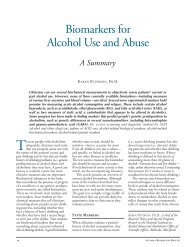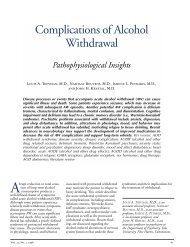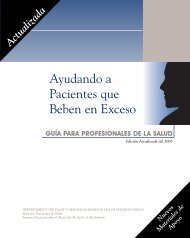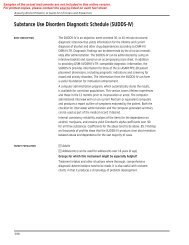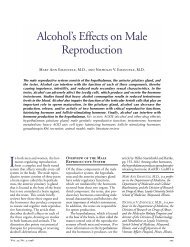Alcohol Syndrome (FAS) and Other Alcohol-Related Birth Defects
Alcohol Syndrome (FAS) and Other Alcohol-Related Birth Defects
Alcohol Syndrome (FAS) and Other Alcohol-Related Birth Defects
You also want an ePaper? Increase the reach of your titles
YUMPU automatically turns print PDFs into web optimized ePapers that Google loves.
the most consistent neurobehavioral effect of prenatal alcohol exposure observed in<br />
older children. Cognitive deficiencies <strong>and</strong> other alcohol-related neurobehavioral deficits<br />
are the most common, but least diagnosed sequellae associated with prenatal alcohol<br />
exposure. Behavioral <strong>and</strong> mental problems of children with FAE can be just as severe as<br />
those with <strong>FAS</strong>. Many children with <strong>FAS</strong>/FAE are not able to underst<strong>and</strong> cause <strong>and</strong><br />
effect relationships <strong>and</strong> long-term consequences. These characteristics predispose the<br />
affected individuals to delinquency.<br />
THE BIOLOGICAL BASIS FOR <strong>FAS</strong> AND OTHER ARBDS<br />
The presentation of alcohol-induced prenatal damage is dependent on the timing<br />
of the insult <strong>and</strong> the amount <strong>and</strong> pattern of maternal drinking (peak blood alcohol<br />
concentration). Although excessive alcohol exposure can cause damage at all stages of<br />
in utero development, the embryonic period (weeks 3-8 after fertilization) is the time<br />
when the conceptus is most susceptible to the development of major abnormalities. This<br />
is not surprising considering that during this short period of time, the embryo changes<br />
remarkably in form. It transforms from a “worm-like” shape the size of Roosevelt’s ear on<br />
a dime at four weeks of development to the distinctly human form that is the size of a<br />
quarter by the eighth week after fertilization. At early stages, animals such as rodents<br />
that researchers use in order to study the effects of alcohol, are very similar in their<br />
development to humans. This is one of the reasons that the results of experiments on<br />
these laboratory animals can be extrapolated to humans. In fact, exposure of mouse<br />
embryos to a high dose of alcohol at the time of development that corresponds to<br />
the third week of human development (when the human embryo is about the size<br />
of the inside of the 9 in the year “1994” on the dime) can cause all of the facial<br />
features in mice that are typical of children with <strong>FAS</strong> (transparency #5).<br />
Research has shown that alcohol can kill cells of the developing embryo.<br />
Different cells of the embryo are sensitive at different stages of development.<br />
Some of the cells in the developing brain <strong>and</strong> face are particularly sensitive<br />
(transparency #6). Finding the pattern of cell death caused by ethanol at various stages<br />
of development provides important clues for underst<strong>and</strong>ing the long-term consequences<br />
of maternal alcohol abuse in affected humans.<br />
Research in animals has made it clear that alcohol can be very damaging even<br />
at very early stages of development. In fact, at some of the early, vulnerable stages,<br />
most women are unaware that they are pregnant.<br />
DOSAGE AND WARNINGS<br />
Everyone wants to know “how much is too much”. Although alcohol-related birth<br />
defects are believed to be induced in a dose-response manner, low dose effects are<br />
very difficult to scientifically assess in human populations. Whether there is a threshold<br />
below which alcohol can be consumed without harming the conceptus is not known.<br />
Also, due in part to individual variability (susceptibility), research will not be able to<br />
provide an accurate answer for everyone. To date, studies indicate that most<br />
neurobehavioral effects can be caused by a pregnant woman drinking from 0.5 to 2<br />
ounces of absolute alcohol per day (7 – 28 drinks with each containing 0.5 ounces of<br />
absolute alcohol per week; an 8 oz. can of beer contains the same amount of alcohol as<br />
a glass of table wine or a serving of fortified wine or a 1 oz. shot of liquor). Although this<br />
would indicate that even one drink per day can cause measurable consequences to the<br />
offspring, the drinking patterns of many of the women studied were such that the<br />
majority of the drinks consumed in one week were on only one or two occasions, rather



